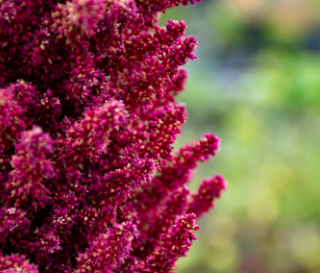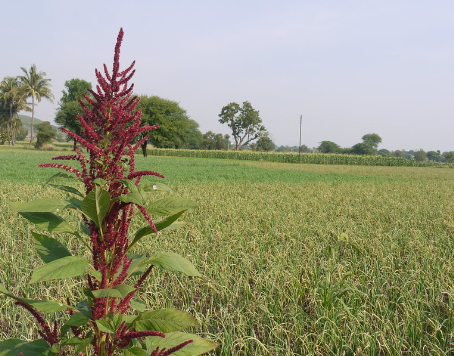Do you ever wonder if deer enjoy munching on your beloved amaranth? You’re not alone.
Many gardeners face the challenge of deer snacking on their plants. While these graceful animals can be a joy to watch, they can also wreak havoc on your garden.

Amaranth (also known as amaranthus, Chinese spinach, or Joseph’s coat) is often considered to be deer-resistant. This is because its leaves and stems have textures and tastes that are not usually appealing to deer.
You might find that planting amaranth might keep your other plants safe as well.
Interestingly, even though amaranth is not a favorite of deer, they are known to eat almost anything when food is scarce.
If you notice deer damage on your amaranth or other plants, it might be time to consider additional protective garden options against deer.
Your garden can still thrive with a bit of strategy and the right plant choices.
Keep reading to discover more about how to protect your plants from deer and enjoy a beautiful, lush garden.
Do Deer Eat Amaranth?

Deer generally avoid eating amaranth. They prefer browsing on other plants rather than munching on the leaves of amaranth.
This plant has a somewhat unappetizing texture for deer, making it less attractive to them.
If you grow amaranth in your garden, you might find that it remains untouched. In contrast, other plants may show signs of nibbling and damage.
Globe amaranth is another variety that deer often pass by. Its dense flower buds are less appealing to their taste buds.
Compared to grazing animals like cows and sheep, deer are more selective. They move from plant to plant, sampling a little here and there. They prefer broadleaf plants, but amaranth doesn’t usually make their list.
Choosing to plant amaranth can be a great way to keep your garden looking vibrant without worrying about frequent deer damage.
The vibrant colors of its leaves and flowers add beauty to your space, while remaining mostly carefree from deer.
Some amaranth varieties include red-striped leaves, which are popular in dishes and can add a splash of color to your meals.
If you want to deter deer, amaranth can be a practical and aesthetic choice for your garden.
Are Amaranth Deer Resistant?

Yes, amaranth is often considered deer resistant.
Deer tend to avoid amaranth because of its strong scent and bitter taste. These factors make amaranth less appealing to deer compared to other plants.
Amaranth is also a deer-resistant plant that stands tall and strong, making it hard for deer to nibble on it extensively.
While no plant is completely safe from hungry deer, they will rarely choose amaranth when there are other, more palatable options available.
Types of Amaranth:
- Perennials
- Annuals
Both types can deter deer due to their characteristics.
Other deer-resistant plants such as fragrant plants or those with a bitter taste can also help keep deer at bay.
Use amaranth in your garden to protect other sensitive plants. It can act as a natural deterrent, reducing the need for fences or sprays.
Using deer-resistant annuals like amaranth can help maintain the beauty of your garden while minimizing damage from deer.
Keep in mind that the effectiveness of any deer-resistant plant can vary based on your environment and the food availability for deer.
How To Keep Deer From Eating Amaranth

Deer can be a challenge for gardeners. Here are some ways to protect your amaranth.
Use Deer-Resistant Varieties: Plant deer-resistant perennials and annuals. These plants are less tasty to deer.
Physical Barriers: Fencing and netting can keep deer away. Make sure the fence is high enough.
Repellents: Sprays with strong scents can deter deer. Reapply after rain.
Alternate Food Sources: Plant other food sources away from your garden. This can distract deer from your amaranth.
Walkways: Create walkways or paths around your garden. These can act as an additional barrier.
Will Amaranth Grow Back After Being Eaten By Deer?
Amaranth can regrow after being eaten by deer, but it requires some care to help it recover. You’ll need to create a suitable environment for healthy regrowth and protect it from future deer damage.
Steps To Help Your Amaranth Recover From Deer Damage
Trim Damaged Areas
- Remove any severely damaged or dead parts of the plant. This encourages new growth.
Watering and Soil Care
- Keep the soil moist, especially during the early stages of recovery. Water deeply but less frequently to encourage root growth.
Fertilize Lightly
- Use a balanced fertilizer to provide essential nutrients. This boosts the plant’s strength and promotes healthy new shoots.
Protect from Deer
- Install a fence or use deer repellents around the garden. This prevents further damage as the plant recovers.
Understanding Deer’s Diet And Amaranth
Deer have changing food preferences based on the season, and their diet can include various plants, leaves, and foliage. Amaranth’s unique properties make it a notable plant in relation to deer diet.
Seasonal Variations In Deer’s Diet
Deer’s diet changes with the seasons. In early spring, they eat tender new growth, including early blooming plants like ageratum houstonianum.
During late summer, deer might focus on mature plants with higher protein content. This includes amaranth, whose leaves are less appealing due to their texture and bitterness.
Amaranth’s foliage remains mostly intact even when deer population is high, as they prefer other, more palatable plants. By understanding these preferences, you can better manage your garden throughout the year.
What About Other Wildlife And Amaranth?
Amaranth isn’t only intriguing to deer. It’s also quite interesting to a variety of other wildlife.
Pollinators such as butterflies are attracted to the flowers of amaranth. You might see them flitting around your garden, adding a touch of beauty while helping pollinate the plants.
Wild plants like rosemary and lavender may also attract butterflies.
Birds enjoy the seeds of amaranth. If you let the plants go to seed, you might find birds like sparrows and finches visiting your garden to feast.
These seeds are a great natural food source for many bird species.
Certain insects might munch on amaranth leaves. While this could be seen as a drawback, it also means your garden contributes to the local ecosystem by providing food for different creatures.
Plants like marigold and sweet alyssum can attract beneficial insects which help control pests naturally.
Despite amaranth’s resilience, it can still be impacted by plant-eating creatures. For example, rabbits and insects like webworms may eat its leaves. Keeping an eye on these common pests can help maintain the health of your amaranth plants.
Comparing it to other garden favorites, zinnias and snapdragons might attract similar wildlife. Like amaranth, they bring in pollinators and can be part of a balanced garden ecosystem.
In designing a garden, consider companion plants. Catmint and calendula can complement amaranth, encouraging a diverse habitat for wildlife.
Whether for pollinators, birds, or insects, amaranth plays a role in a thriving garden environment.
